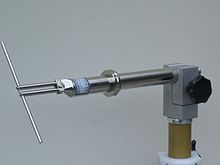


In radio and telecommunications a dipole antenna or doublet[1] is one of the two simplest and most widely-used types of antenna; the other is the monopole.[2][3][full citation needed] The dipole is any one of a class of antennas producing a radiation pattern approximating that of an elementary electric dipole with a radiating structure supporting a line current so energized that the current has only one node at each far end.[a] A dipole antenna commonly consists of two identical conductive elements[5] such as metal wires or rods.[2][6][7](p 3) The driving current from the transmitter is applied, or for receiving antennas the output signal to the receiver is taken, between the two halves of the antenna. Each side of the feedline to the transmitter or receiver is connected to one of the conductors. This contrasts with a monopole antenna, which consists of a single rod or conductor with one side of the feedline connected to it, and the other side connected to some type of ground.[7] A common example of a dipole is the rabbit ears television antenna found on broadcast television sets. All dipoles are electrically equivalent to two monopoles mounted end-to-end and fed with opposite phases, with the ground plane between them made virtual by the opposing monopole.
The dipole is the simplest type of antenna from a theoretical point of view.[1] Most commonly it consists of two conductors of equal length oriented end-to-end with the feedline connected between them.[8][9] Dipoles are frequently used as resonant antennas. If the feedpoint of such an antenna is shorted, then it will be able to resonate at a particular frequency, just like a guitar string that is plucked. Using the antenna at around that frequency is advantageous in terms of feedpoint impedance (and thus standing wave ratio), so its length is determined by the intended wavelength (or frequency) of operation.[2] The most commonly used is the center-fed half-wave dipole which is just under a half-wavelength long. The radiation pattern of the half-wave dipole is maximum perpendicular to the conductor, falling to zero in the axial direction, thus implementing an omnidirectional antenna if installed vertically, or (more commonly) a weakly directional antenna if horizontal.[10]
Although they may be used as standalone low-gain antennas, dipoles are also employed as driven elements in more complex antenna designs[2][5] such as the Yagi antenna and driven arrays. Dipole antennas (or such designs derived from them, including the monopole) are used to feed more elaborate directional antennas such as a horn antenna, parabolic reflector, or corner reflector. Engineers analyze vertical (or other monopole) antennas on the basis of dipole antennas of which they are one half.
- ^ a b Winder, Steve; Carr, Joe (2002). Newnes Radio and RF Engineering Pocket Book (3rd ed.). Newnes. p. 4. ISBN 0080497470.
- ^ a b c d
Basu, Dipak (2010). Dictionary of Pure and Applied Physics (2nd ed.). CRC Press. p. 21. ISBN 978-1420050226. - ^
Hille, K., DL1VU. Der Dipol in Theorie und Praxis [The Dipole, in Theory and Practice] (in German).
{{cite book}}: CS1 maint: multiple names: authors list (link) CS1 maint: numeric names: authors list (link)[full citation needed] - ^ Bodnar, Donald (1993). IEEE Standard Definitions of Terms for Antennas (Report). New York, NY: Institute of Electrical and Electronics Engineers. §2.102, page 10. ANSI/IEEE Std 145-1993.
- ^ a b "Dipole antenna". aerial tutorial. Radio-Electronics.com. Resources. Adrio Communications. 2011. Retrieved 29 April 2013.
- ^ Rouse, Margaret (2003). "Dipole antenna". Online IT Encyclopedia. Retrieved 29 April 2013 – via whatis.techtarget.com.
- ^ a b Cite error: The named reference
Balaniswas invoked but never defined (see the help page). - ^ Stutzman, Warren; Thiele, Gary (1981). Antenna Theory and Design. John Wiley & Sons. pp. 212–220. ISBN 0-471-04458-X.
- ^ Huggins, John (31 December 2016). "Of fields and feedpoints". Hamradio.me. Retrieved 13 January 2017.
- ^ Stutzman, Warren L.; Thiele, Gary A. (2012). Antenna Theory and Design. John Wiley and Sons. pp. 74–75. ISBN 978-0470576649.
Cite error: There are <ref group=lower-alpha> tags or {{efn}} templates on this page, but the references will not show without a {{reflist|group=lower-alpha}} template or {{notelist}} template (see the help page).